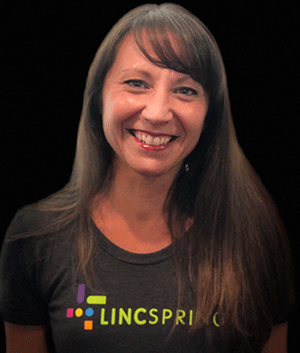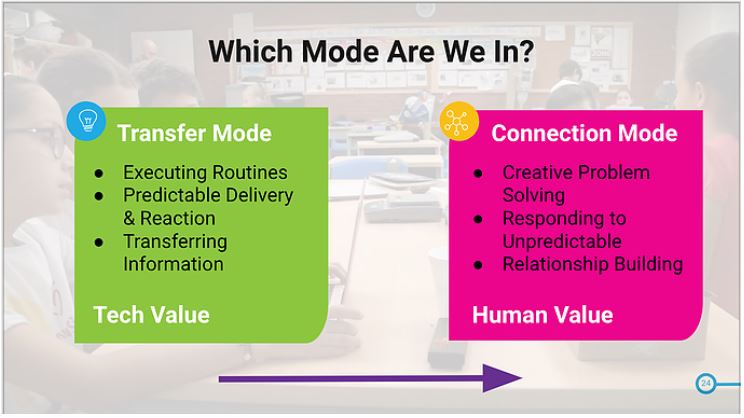Why Make the Shift: How I Reimagined My Job of Being a Teacher
 It was 2012, and I was standing in my classroom, after just leaving a workshop for this Learning Management System called Schoology. I had fifteen years of teaching under my belt, and I thought to myself, “Why make this shift in my practice? I’ve had a consistent good run: strong relationships with students and families, effective teaching and class management strategies measurable by academic and social-emotional growth, and great performance evaluations. I know what I’m doing. I got this!”
It was 2012, and I was standing in my classroom, after just leaving a workshop for this Learning Management System called Schoology. I had fifteen years of teaching under my belt, and I thought to myself, “Why make this shift in my practice? I’ve had a consistent good run: strong relationships with students and families, effective teaching and class management strategies measurable by academic and social-emotional growth, and great performance evaluations. I know what I’m doing. I got this!”
But, there was a tickle in the back of my mind because I also knew in the last few years, I had watched the world change as a result of rapid technological advancements, and I didn’t see that reflected in my teaching. I knew that I wasn’t really preparing students for their new world. I reminded myself that this was the charge I accepted when I started teaching: to ensure that my students left my room with the relevant, critical skills that would prepare them for the future. I knew I would need to do more professional learning if I was going to transform my practice and stay true to that goal.
So I committed myself to this transformation. It was hard, and it was messy. I often wanted to revert to my comfort zone (the way that had worked for so long), but what I saw in my students inspired me to keep at it. Because they had more agency and control over the pace of their learning, their engagement and ownership skyrocketed. In addition, I noticed colleagues started asking questions about what I was doing with my class. Teachers are a curious, creative bunch, and I found that with enthusiastic and gentle nudges, they started tinkering with these new methods in their own classrooms - They were also finding their spark!
It’s 2019, and I am now a blended learning coach and school transformation agent with LINC, the Learning Innovation Catalyst. I decided to write this piece to speak to all of us teachers who are out there trying to reconcile our vision of ourselves as teachers in this modern day, tech-driven world.
My hope is to leave you with a way to re-envision your teacher self, while honoring your teacher heart (the reason you became a teacher). This two-part progression is the way I framed my thinking when I was transforming my teaching practice to become a student-centered 21st century classroom.
First: Acceptance
There is no denying that our role as teachers must change, and if teachers avoid this fact, then it is inevitable that their practice will become increasingly disconnected from the real world. While no teacher wants their practice to be considered irrelevant, many of us still cling to traditional practices that supported a different world. Our resistance is not because we don’t care or deny this shift, it’s because in many cases, we have not been set up or prepared to succeed. Dr. Arnetha Ball, our research collaborator and professor at Stanford University explains this as teachers being viewed oftentimes as “objects” of change, instead of the “agents” of change.
This challenge is further complicated by the fact that we are not even sure what to prepare our students for. There are predictions that 85% of jobs in 2030 haven’t even been created yet and almost half of existing jobs may be gone by 2035. We are in the throes of a technological revolution, and that’s a fast moving target! With skills uncertainty, automation, and students who are grappling with significant social/emotional issues, a teacher’s job is more confusing than ever. Teachers are rightfully tired and stressed. Most of us entered this profession with a mission to inspire and connect with our students, and we don’t seem to have the tools, resources, and time to do this anymore.
One way we can approach this challenge is to accept that things must change and then reimagine ourselves as teachers. This will require letting go of some closely-held beliefs about who we are and create an entirely different vision of our life’s work. Ouch, not easy to do! But, it is necessary if we are going to meet our responsibility to educate our students. Luckily, once we accept that change, it becomes much easier to begin the mindset shift.
Second: Mindset Shifts
We operate in two distinct modes everyday in our classrooms: Connection Mode and Transfer Mode. We all know that our brightest memories of our teaching careers happen during that magical moment, when the light bulb goes on and you see the confidence and joy in the student’s eyes. It’s because at that very instant, we’ve achieved our goal to help that student recognize and believe in their own ability to learn. I’m willing to say that most of those memories don’t happen when the teacher is lecturing at the front of the room, while students take pages of notes or during the end of unit test. These powerful moments occur during a Connection Mode situation: sitting with a small group of students reviewing a concept, during a student conference, having a community circle discussion, or after class when you have the opportunity to be present and talk to the student. So, the first mindset shift can begin here, by planning instruction to get more time in Connection Mode.

There is also an opportunity in Transfer Mode to embrace a mindset shift. Here’s where it gets dicey for teachers, especially those of us who have been at this for decades! Transfer mode is where the content gets delivered. We can all agree that each grade level has an enormous amount of standards to address, and it’s the teachers job to get that information to the students. Traditionally, that has been done in a teacher-centered manner in which the teacher holds the information and transfers it to students, usually through talking while students listen and then reproduce that same information to be graded. Here it comes...this is where the tech can (in a sense) replace us. Yes, I said, “Replace.” Through technology, we now have immediate access to content and information beyond what any one teacher brain can hold.
But wait, don’t leave me here! Turning over the transfer of information to the tech doesn’t mean your expertise and years of honing your delivery skills are for naught. By leveraging the tech to expose students to the content, you can move from the front of the room and sit with students in carefully designed groups or even individually. You can finally get to the meaningful work of analysis, real world application, creativity, and of course, connection. In this mindset shift, we aren’t changing the “what” we teach, we are changing the “how” we teach it.
If you made it this far, I want to thank you. I wrote this because I know teachers have the drive and passion to do this work; we just need to be set up to succeed. As much as we deserve outside support, the first steps toward success are not outside of us, but with acceptance of our new world and shifting our mindset. Be patient and have compassion for yourself when challenges arise through this transition, but stay the course. The rest of the world is like a bullet train. Jump on and seize the opportunity to create a dynamic, engaging 21st century classroom where if someone asked you, “Would you want to be a student in your class?” you could wholeheartedly answer, “YES!”